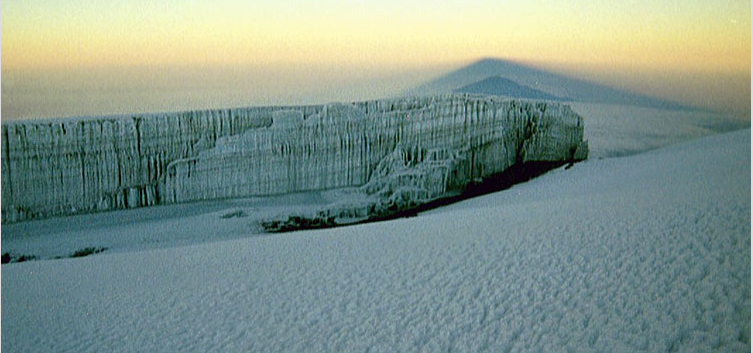Mount Kilimanjaro Shadow
Exploring the Enigmatic Mount Kilimanjaro Shadow
Mount Kilimanjaro, located in Tanzania, is not only Africa's highest mountain, towering at an impressive 5895 meters (19,300 feet), but it also possesses a captivating atmospheric phenomenon known as the "Mount Kilimanjaro Shadow." This intriguing shadow has been observed and documented by many nature enthusiasts and photographers over the years, adding to the allure of this majestic peak.
The Triangular Shadow and its Formation
The Mount Kilimanjaro Shadow takes on a distinctive triangular shape due to the conical structure of the mountain. As the sun rises or sets, casting its warm golden rays across the landscape, the mountain projects its elongated shadow into the atmosphere. The shadow extends far into the distance, creating a mesmerizing visual spectacle.
Coincidental Alignment with Mount Meru
One remarkable aspect of the Mount Kilimanjaro Shadow is its occasional alignment with Mount Meru, a nearby mountain located approximately 30-40 kilometers away. The long shadow cast by Kilimanjaro appears to pass directly over Mount Meru, creating a surreal connection between the two prominent peaks. This natural phenomenon has been captured in photographs, leaving viewers in awe of nature's incredible precision and beauty.
Atmospheric Optics and the Mount Kilimanjaro Shadow
The formation of the Mount Kilimanjaro Shadow is a result of atmospheric optics, a branch of science that explores how light interacts with various atmospheric conditions. When sunlight passes through the Earth's atmosphere, it undergoes scattering and refraction, leading to the creation of fascinating optical phenomena such as rainbows, halos, and shadows.
Sunrise and Sunset Enhancing the Phenomenon
The captivating Mount Kilimanjaro Shadow is most prominently visible during sunrise and sunset. As the sun ascends or descends on the horizon, the low angle of its rays elongates the mountain's shadow, intensifying its triangular shape. This unique lighting effect adds a touch of enchantment to the already awe-inspiring landscape, leaving observers captivated by the interplay between light and shadow.
Weather Conditions Influencing the Shadow's Appearance
While the Mount Kilimanjaro Shadow is a regular occurrence, its visibility can be influenced by weather conditions. Clear skies and minimal cloud cover provide optimal conditions for the shadow to be vividly displayed. On days with heavy cloud cover or atmospheric haze, the shadow may be less distinct or even obscured entirely, leaving onlookers eagerly awaiting clearer conditions to witness this natural spectacle.
Cultural Significance and Local Legends
The Mount Kilimanjaro Shadow holds cultural significance for the local communities living in its vicinity. In Tanzanian folklore, it is believed that the shadow represents the presence of ancestral spirits or guardian deities watching over the land. This deep-rooted belief adds a spiritual dimension to the already mystical phenomenon, further ingraining it into the cultural fabric of the region.
Capturing the Magic: Photography and the Mount Kilimanjaro Shadow
Photographers from around the world are drawn to Mount Kilimanjaro to capture the ethereal beauty of its shadow. The mountain's impressive height, combined with the striking triangular shape of its shadow, offers a perfect subject for artistic exploration. From professional photographers to avid hobbyists, many have ventured to Kilimanjaro's slopes in pursuit of that perfect shot, immortalizing the enigmatic shadow for others to marvel at.
The Mount Kilimanjaro Shadow as a Symbol of Adventure
Beyond its scientific and cultural significance, the Mount Kilimanjaro Shadow has also become a symbol of adventure and exploration. Mount Kilimanjaro is a popular destination for hikers and mountaineers seeking to conquer its lofty peak. The presence of the shadow serves as a constant reminder of the mountain's grandeur and the challenges that await those who dare to ascend its slopes.
Preserving the Natural Wonder
As the Mount Kilimanjaro Shadow continues to captivate the hearts and minds of those fortunate enough to witness it, it is crucial to prioritize its preservation. Protecting the natural environment surrounding Mount Kilimanjaro is essential to ensure that future generations can experience the magic of this atmospheric phenomenon. Conservation efforts and responsible tourism practices play a vital role in safeguarding the mountain and its shadow for years to come.
In conclusion, the Mount Kilimanjaro Shadow stands as a testament to the beauty and complexity of our natural world. Its triangular shape, coincidental alignment with Mount Meru, and the interplay between light and shadow create a captivating spectacle that continues to inspire awe and wonder. Whether viewed through the lens of science, culture, or adventure, this atmospheric phenomenon reminds us of the immense power and artistry found within our planet's ever-changing skies.

Kilimanjaro, Tanzania. Africa's highest mountain at 5895m (19,300ft) is a multipeaked stratovolcano, flat topped in profile (right). Olivier Rouah caught its triangular shadow from the highest Uhuru summit shortly after sunrise in August 2003. The long shadow cast into the air coincidentally passes over Mount Meru (15,090ft) some 30-40km distant. Image @Olivier Roush, shown with permission

Note: this article has been automatically converted from the old site and may not appear as intended. You can find the original article here.
Reference Atmospheric Optics
If you use any of the definitions, information, or data presented on Atmospheric Optics, please copy the link or reference below to properly credit us as the reference source. Thank you!
-
<a href="https://atoptics.co.uk/blog/mount-kilimanjaro-shadow/">Mount Kilimanjaro Shadow</a>
-
"Mount Kilimanjaro Shadow". Atmospheric Optics. Accessed on November 26, 2024. https://atoptics.co.uk/blog/mount-kilimanjaro-shadow/.
-
"Mount Kilimanjaro Shadow". Atmospheric Optics, https://atoptics.co.uk/blog/mount-kilimanjaro-shadow/. Accessed 26 November, 2024
-
Mount Kilimanjaro Shadow. Atmospheric Optics. Retrieved from https://atoptics.co.uk/blog/mount-kilimanjaro-shadow/.